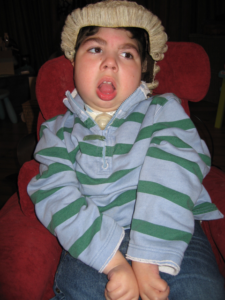Why was the AdsFoundation established?
 The AdsFoundation draws on Adam Bojelian’s health experience and advocacy together with Dr Zoe Picton-Howell’s (Adam’s mum) professional expertise as a lawyer, academic researcher, healthcare law and ethics tutor and work with healthcare professionals and voluntary organisations nationally.
The AdsFoundation draws on Adam Bojelian’s health experience and advocacy together with Dr Zoe Picton-Howell’s (Adam’s mum) professional expertise as a lawyer, academic researcher, healthcare law and ethics tutor and work with healthcare professionals and voluntary organisations nationally.
Our principle aim is to improve staff and patient well-being through a different understanding of healthcare law and ethics than that traditionally taught, both formally and informally, to healthcare professionals.
Our work has found that law and ethics is traditionally viewed as rules and regulations turned to when things go wrong. This view potentially create fear amongst professionals, having a detrimental impact on both their own and their patients’ well-being.
AdsFoundation aims to help professionals to understand law in a different way, as part of their everyday lives and useful tools to promote the best possible patient care and staff well-being. We aim to help professionals understand the close links between law and ethics correctly applied and the values the very best professionals seek to live and inspire. Good communication, including active listening, it essential here.
A key finding of Dr Zoe Picton-Howell’s PhD, which explored with UK paediatric consultants how they make end-of-life decisions for disabled children and their understanding of the relevant law and ethics, illustrates this well. In that study the consultants were found to divide into two groups. The hardliners, so called because one the consultants used this term to describe herself, saw themselves as very knowledgeable about law, regarding themselves as experts in law and ethics and were often also viewed as such by their colleagues. They had studied some healthcare law and ethics and were, for example, very familiar with some of the leading cases. They saw law and ethics as the central to their end-of-life decisions making. They described how they made their end-of-life decisions following strict rules, often rules they had created for themselves, an example cited by several consultants being that a child believed to have severe learning disabilities should not be admitted to intensive care for treatment, as prolonging their lives would not be in their best interests. The hardliners tended to see the decisions as their responsibility and tended not to consult widely with colleagues and others. They focused on the negative impacts of any treatment and tended not to balance these against any benefits. They described disabled children in very negative terms and rejected the possibility that a severely disabled child might ever be able to take part in a decision about his or her healthcare. They also tended to conflate physical impairment with severe cognitive impairment, assuming a child with the former will inevitably have the later, irrespective of any evidence available to the contrary. They also used negative language about parents, for example, using terms such as ‘delusional‘ to described parents who did not share their view of a child’s quality of life.
The other group of consultants were the softliners. This group of consultants described making end-of-life decisions for disabled children very differently. Softliners said they did not see the law as particularly relevant to their decisions and did not see themselves as being particularly knowledgeable about law. They instead described their end-of-life decisions as being about a series of conversations and building relationships. They did not see themselves as the decision maker, but more as the consensus builder.
Softliners consulted widely, with other professionals who knew the child well, including not only other healthcare professionals, but also, for example, the child’s social worker and teaching staff. They involved the child’s parents fully in the decision, seeing supporting parents and siblings as a vital part of their role. Whenever possible they also involved the child, to the extent he or she was capable of being involved, in the decision. They used compassionate and supportive language when talking about parents. They acknowledged the expertise parents have often built up through caring for a disabled child over many years and also the pain parents will be suffering due to their child’s serious illness and potential death. They made clear that they valued the child, colleagues and family members.
When the way both groups of consultants make their end-of-life decisions was mapped by Dr Zoe Picton-Howell to the relevant law and ethical guidance, it was found it was the non-legally aware softliners with their wide consultation and compassionate approach who were acting in keeping with the law and ethical guidance, whilst the legally focused hardliners, with their rule dominant decision making, were acting contrary to law and ethical guidance. The softliner approach can also be seen to be much more in keeping with the positive values advocated by health and social care organisations, than the ‘legalistic’ hardliner approach.
These finding have heavily influenced AdsFoundation’s aims, with our core focus on the key role of good communication and relationship building as a cornerstone of legal and ethical healthcare.
Adam’s experience also echo these findings. He was treated at different times by hardliners and softliners. When treated by softliners he always received the very best possible care, because he was treated as an individual. When treated by hardliners Adam was treated as a ‘type of child’, prejudical assumptions were made about him and his care was awful, he suffered greatly, as did his parents and all who cared about him. But so too did the staff, rather than engaging, welcoming questions and wanting to learn about Adam, they closed down conversations, were fearful of questions and in the worst cases, their fear of ‘the law’ led them to become hostile and in one extreme case verbally abusive, at the very time their compassion and support was most needed. Their fear of law, harmed them and their colleagues, as much as it harmed Adam and his family.
Adam wrote a blog ‘What does good care look like‘ which has been widely shared by health professionals and others internationally. That blog could rightly have been entitled, ‘What does lawful and ethical care look like?‘
“What Does Good Care Look Like?
The Thoughts of Adsthepoet
I am 13 years old and I have spent more than half my life in hospital.
I’ve seen the best and the worst of the NHS and stayed in five regional Children’s Hospitals; Southampton General; Edinburgh Children’s; Yorkhill (Glasgow); GOSH and Leeds General. The care I have received in all these hospitals but one has been outstanding. In that one, some of the care has been wonderful but some has sadly been awful.
I think everybody should have good care, so to help, I thought I would let you know what, from my experience I think makes good care.
In the good hospitals:-
1) Staff talk to me and involve me in decisions about my care. They ask me about what I want and don’t want;
2) Staff talk to mum and dad and ask them about me;
3) Staff talk to each other and pass on important information about me;
4) If staff don’t know something they are not afraid to say and ask someone who does know, sometimes that might even be me or mum and dad;
5) Staff treat me as an individual and recognise the things I can do, they don’t jump to negative stereotypes and prejudices about me, because I am physically impaired;
6) Staff have time for me, they are friendly and chatty and make me feel as if I matter;
7) Staff are friendly and chatty to mum and dad, they work with them, they treat us all as if we matter;
8)I’m never left alone when I’m seriously ill and never in a room with the door closed so staff can’t see me;
9) When I’m really ill doctors come quick and do everything necessary to make me better, I’m not left critically ill for hours without care;
10) I always feel that I am getting the best care possible, I’m never made to feel like a second class citizen for whom it doesn’t matter if I live or die.
In the bad hospital they do the opposite and worse, but want to send a big THANK YOU to all the staff at that hospital who have given me good care and to all the staff at the other hospitals- You are the best!”
Adam Bojelian
26th April, 2013
BACK to WHO was Adam Bojelian ?
FORWARD to Who is Dr. Dog?


 The AdsFoundation draws on Adam Bojelian’s health experience and advocacy together with Dr Zoe Picton-Howell’s (Adam’s mum) professional expertise as a lawyer, academic researcher, healthcare law and ethics tutor and work with healthcare professionals and voluntary organisations nationally.
The AdsFoundation draws on Adam Bojelian’s health experience and advocacy together with Dr Zoe Picton-Howell’s (Adam’s mum) professional expertise as a lawyer, academic researcher, healthcare law and ethics tutor and work with healthcare professionals and voluntary organisations nationally.